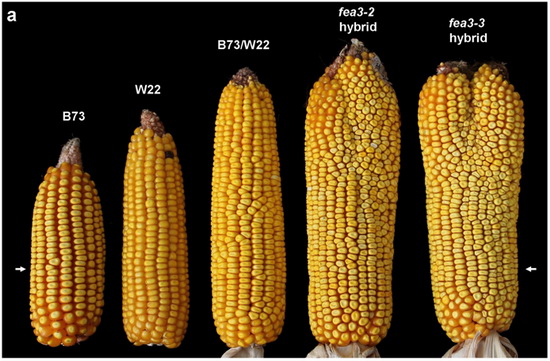
Newly Discovered Stem Cell Pathway Will Increase Yields of Maize and Staple Crops
May 18, 2016| |
Biologists at Cold Spring Harbor Laboratory (CSHL) have made an important discovery that helps explain how plants regulate the proliferation of their stem cells. The newly discovered pathway channels signals from a plant's extremities (primordia) to the stem cell niche (meristem) located at the plant's growing tip.
The group led by CSHL Professor David Jackson identified the "braking signals from the leaves" in cells in the lower part of the meristem. They named the receptor FEA3. They also discovered the ligand that interacts with the receptor, a protein fragment called FCP1. Jackson's team studied maize plants in which FEA3 was dysfunctional.
When FEA3 receptors in the meristem are not able to function at all, "it is as if they are blind to FCP1," says Jackson. The inhibitory signal FCP1 sends from the leaves to the meristem is not received, and stem cells proliferate wildly. The plant makes too many stem cells, giving rise to too many new seeds that the plant cannot support with available resources.
When the team grew plants with "weak alleles" of the FEA3 gene, the function of the FEA3 receptor was only mildly impaired. This moderate failure of the braking signal from outside of the meristem gave rise to a modest, manageable increase in stem cells, and to ears that were significantly larger than ears in wild-type plants. These ears had more rows of kernels and up to 50 percent higher yield than wild-type plants.

Photo source: Cold Spring Harbor Laboratory
For more information, read the news release at the CSHL website.
| |
Biotech Updates is a weekly newsletter of ISAAA, a not-for-profit organization. It is distributed for free to over 22,000 subscribers worldwide to inform them about the key developments in biosciences, especially in biotechnology. Your support will help us in our mission to feed the world with knowledge. You can help by donating as little as $10.
-
See more articles:
-
News from Around the World
- U.S. National Academies Find Biotech Crops Not Harmful to Human Health and the Environment
- Glyphosate Unlikely Carcinogenic to Humans, Says Joint WHO/FAO Committee Report
- Cairo University Celebrates Biotech Day 2016
- FSU-Cornell Research Team Discovers 'Dark Matter' in Maize Genome
- Newly Discovered Stem Cell Pathway Will Increase Yields of Maize and Staple Crops
- Parliamentary Report Confirms Importance of Agricultural Innovation in Australia
- Bt Cotton Adoption Creates More Employment Opportunities in Female Laborers in Pakistan
- Chinese Scientists Evaluate Performance of Plant Gene as a Selectable Marker for Rice Transformation
- Agri Minister Matia Chowdhury Speaks on Biotech Efforts in Bangladesh
- First State of the World's Plants Report Launched
-
Research Highlights
- Asian Corn Borer Parasite Not Sensitive to Bt Toxin
- MdMLO19 Gene Knockdown in Apple Reduces Susceptibility to Powdery Mildew
- Researchers Analyze Rice QTL for Grain Size and Yield
-
Beyond Crop Biotech
- Scientists Genetically Engineer First Zika Virus Clone
-
Announcements
- SolGenomics Conference
-
Read the latest: - Biotech Updates (December 17, 2025)
- Gene Editing Supplement (December 17, 2025)
- Gene Drive Supplement (February 22, 2023)
-
Subscribe to BU: - Share
- Tweet
